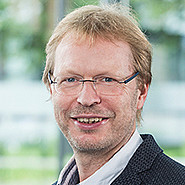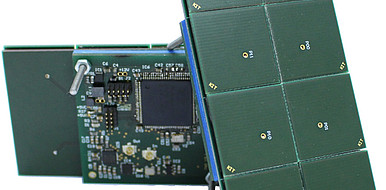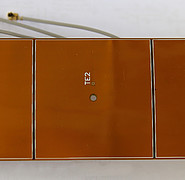A serendipitous sensor system
Robot technology has become established in many industry areas, such as production, logistics, agriculture or maintenance. The robots are equipped with sensors for particularly delicate manoeuvres in order to make the arms and grippers more sensitive.
State of the art
So far, the sensors used have usually been restricted to just one function: Either they detect movements by approaching an object or by touching in the form of pressure.
Technology
Researchers at the KIT Institute for Anthropomatics and Robotics have developed a modular sensor system with an enhanced sense of feel and touch that combines both functions and can even detect using them simultaneously. An individual sensor module consists of just three layers: there is a large-surfaced bottom electrode, followed by an insulating intermediate layer consisting of a compressible material such as foam rubber. Several geometric, regularly arranged covering electrodes combine to form the upper layer. The number and form of the covering electrodes depend on the respective application. The control electronics, which can be installed spatially separated from the sensors, completes a sensor module or a module network system consisting of several modules. The covering electrodes can be combined in any way, enabling a compromise between locational resolution and range of the sensor. Whether and how objects are moving around the sensor system is detected via its capacitive coupling with the environment or the surrounding objects. If an object is approaching, the electric field surrounding the sensor will change. This change is evaluated as approximate information. In contrast, touching, which results in mechanical compression of the intermediate layer, is established as a change in capacity.
Advantages
Several sensor modules can be combined as a sensor surface. For example, robots can be equipped with modules ranging from small surfaces on grippers to a large-surface “robot skin”.
Options for companies
KIT is seeking partners to advance and implement the technology in concrete fields of application, especially in service robotics.
Your contact person for this offer

Innovation Manager Karlsruhe Institute of Technology (KIT)
Innovation and Relations Management (IRM) Phone: +49 721 608-25587
Email: rainer.koerber@kit.edu


